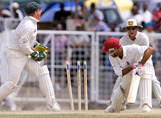COACHING
Keeping Wickets To Spin Bowlers - I
A keeper stands near the stumps for a spin bowler,
the distance usually being two feet from the
stumps. In most cases, the keeper squats outside
the off-stump, and in some very rare instances when
the captain decides to adopt a negative strategy,
he squats outside the leg-stump. Remember James
Foster standing outside the leg-stick while keeping
to Ashley Giles' left-arm spin when English skipper
Nasser Hussain decided to adopt negative tactics
against Sachin Tendulkar in the 2001-02 series
between England and India?
The keeper usually marks his position and also the
line of the three stumps. Standing, or squatting
near the stumps is referred to as 'standing up' to
the bowler.

Ian Healy, the most successful wicketkeeper-batsman in Test history, completes a smart
stumping to send back West Indian Jimmy Adams in the 1998-99 series.
It is critical for a wicketkeeper to be mobile,
energetic, strong, enthusiastic, and also patient
and agile, when a spinner is in operation. He
should be quick on his feet around the stumps.
Quickness on his feet comes in handy to dart around
and prevent cheeky singles.
The keeper should position his gloves above or
outside the edge of the bat, instead of placing
them directly in the line of the ball. He should
expect an edge off every ball. He should stand
close to the stumps, and be able to move around
sideways, so as to cover the angle created after
the ball pitches. This also reduces the distance
between the gloves and the ball and forces him to
gather the ball earlier.
The gloves should be positioned in such a way that
their maximum surface area is exposed, but at the
same time the fingers face either the ground or
sky, or towards the left or right. At no time
should they face the path of the ball.
The keeper should crouch until the ball pitches,
and rise with the ball. Another important thing is
not to grab at the ball, but wait for it to settle
into the gloves. He should try not to make
stumpings in haste, for it may result in a fumble
or a missed chance. He should concentrate on taking
the ball first and then bring it to the stumps. Of
course, this may give the batsman an extra fraction
of a second to return to the crease, but constant
practice will pay in the long run. Dislodging the
bails in a flash will become second nature for the
keeper even before he realizes it!
Condition of the pitch:
Different skills of a keeper come into play on
different types of pitches. On the first two days
of a Test, especially the first, the pitch is
relatively fresh. This affords less turn, but more
speed depending on the amount of grass on the
track. As the match progresses, the condition will
deteriorate with every passing hour and the ball
will start spinning more. The bounce of the ball
will become uneven, and the ball will start playing
all sorts of tricks after pitching, due to wear and
tear. This will require a lot of concentration,
agility and technical soundness.
To be continued...